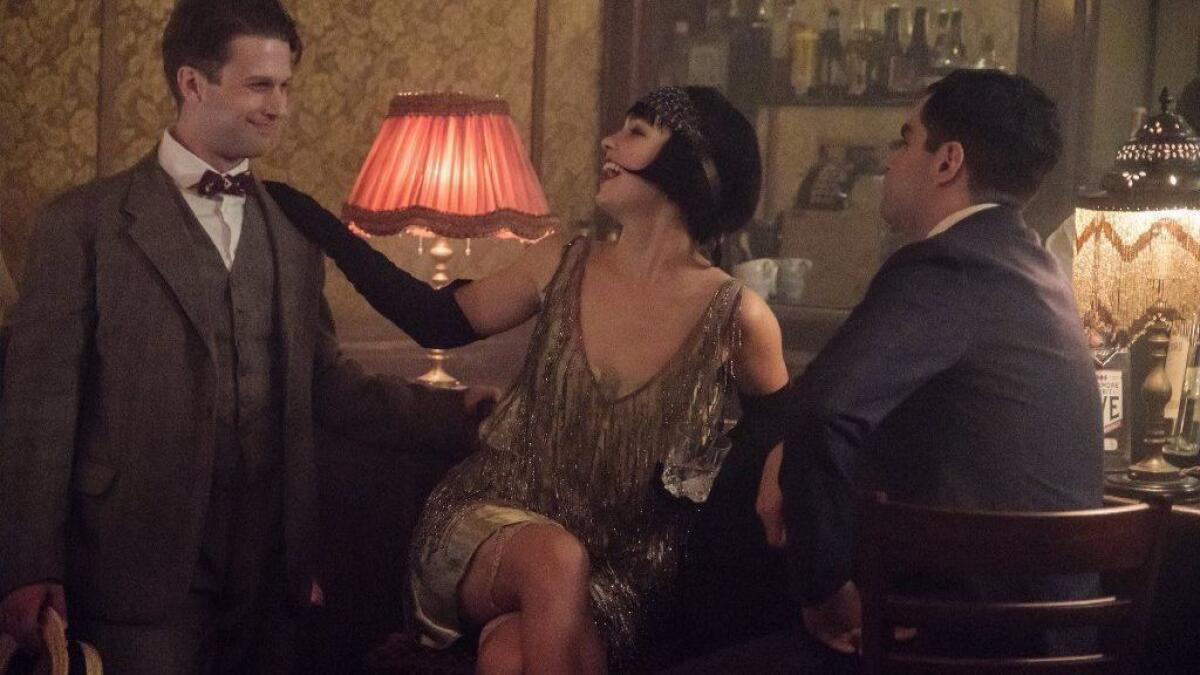Review: Shades of ‘Downton Abbey’ color ‘The Chaperone’

- Share via
“The Chaperone” doesn’t need one. Well-behaved and genteel from the get-go, it has its pleasures, but being wild and crazy is not one of them.
This is more than a little ironic, because one of the film’s protagonists is the real-life Louise Brooks (played here by Haley Lu Richardson), an actress best known for 1929’s provocative “Pandora’s Box” and someone whose incendiary screen presence and free-spirited life gave decorum-seekers fits.
The guiding spirit here, however, is not that G.W. Pabst silent classic but the blockbuster television series “Downton Abbey,” which supplied “Chaperone” with both its writer (Julian Fellowes) and director (Michael Engler) as well as the person who got it going.
That would be producer and star Elizabeth McGovern, who came across the 2012 Laura Moriarty novel that the film is adapted from when she was hired as its audio book reader and recognized it as something she could both act in and help create.
Given her long association with “Downton,” it was likely second nature to McGovern to enlist the help of stalwarts Fellowes and Engler, both currently working on the forthcoming “Downton” feature, which partisans of the series (no names) are keenly awaiting.
But while everyone, including costars Campbell Scott, Geza Rohrig, Miranda Otto and Blythe Danner, works very hard here, there is something in the original concept that resists the kind of energy and psychological interest that made “Downton” so snappy.
For though Louise Brooks is a key participant, the film’s earnest focus, as the title indicates, is on the emotional trajectory of another, not necessarily fascinating woman, the fictional Norma Carlisle (McGovern).
While the real Brooks did spend five weeks in New York studying dance when she was 15 and did go accompanied by a chaperone, nothing is known of that woman, which gave novelist Moriarty the opportunity to make one up, to not necessarily scintillating effect.
We meet Norma in Wichita, Kan., in 1922, where she and her well-to-do husband Alan (Scott) are attending an evening of dance to benefit that city’s Children’s Home.
The star of that event is young Louise, gamboling around the stage in neo-Isadora Duncan white robes so effectively that Norma finds herself charmed by her effervescent energy.
When she hears from Louise’s mother, Myra (Victoria Hill), that Louise needs a chaperone to accompany her to classes given in New York by the biggest names in modern dance, Ruth St. Denis (Otto) and Ted Shawn (Robert Fairchild), she impulsively volunteers for the job.
We immediately are aware, for reasons eventually revealed, that Norma’s marriage is not in an ideal state. But she has another reason for the trip: She originally came to Kansas on an orphan train from Manhattan, and she hopes to gain more information about her past.
Young Louise, by contrast, is interested only in the future and her dream of being the best dancer in the world. A willful spirit who does not believe in rules, not one little bit, she isn’t keen on this chaperone idea but knows as a teenager she has no choice.
Even on the train ride to New York, it soon becomes obvious that Louise is catnip to men of all ages, skilled at getting them to do her bidding and indifferent to the appearance of impropriety.
When the prim Norma sternly advises her that “men don’t like candy that’s been unwrapped,” Louise looks at her like she just fell off the moon.
Once the pair get to New York, each woman follows her own agenda, which for Louise means impressing the hell out of Ted Shawn (“the girl’s a star”) and getting a gimlet-eyed once-over from St. Denis, who believes “art is not tinsel, art is gold.”
As for Norma, she tracks down the New York Home for Friendless Girls (a great name for an organization if ever there was one), but the tough nuns who run the place tell her no good can come of her search for her birth mother.
Fortunately, she runs into German American handyman Joseph (Rohrig, a long way from the Auschwitz of “Son of Saul”), a kind soul with an enigmatic smile who proves helpful in a variety of ways.
It is the conceit of “The Chaperone” that Norma and Louise, different though they are, have an influence on each other’s lives. There are small surprises along the way (references to the constricting nature of corsets not among them) but everything plays out pretty much as expected. Self-actualization may be essential for people, but it doesn’t always make for the best of drama.
----
‘The Chaperone’
Not rated
Running time: 1 hour, 48 minutes.
Playing: Laemmle Royal, West Los Angeles, Playhouse 7, Pasadena, Town Center 5, Encino
More to Read
Only good movies
Get the Indie Focus newsletter, Mark Olsen's weekly guide to the world of cinema.
You may occasionally receive promotional content from the Los Angeles Times.










